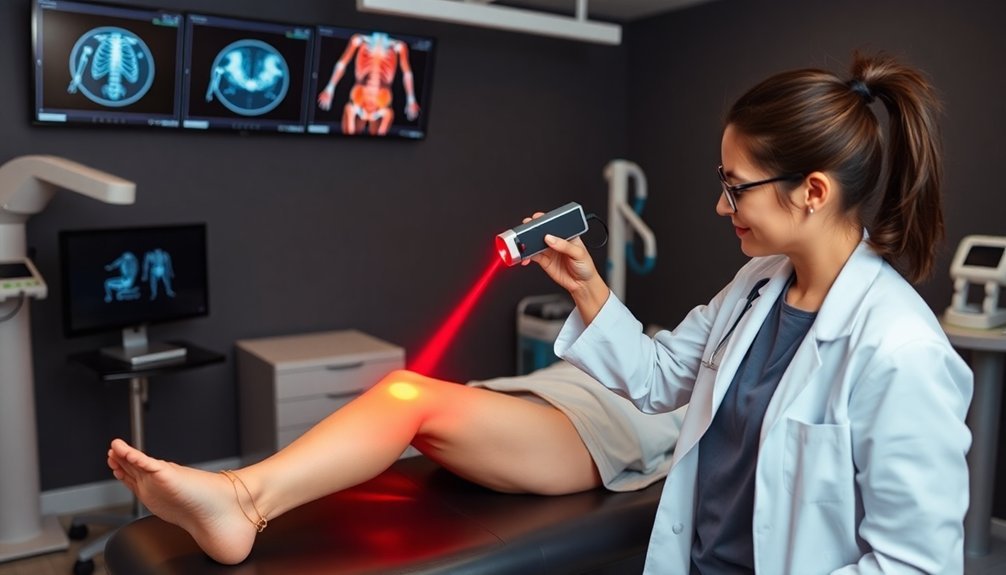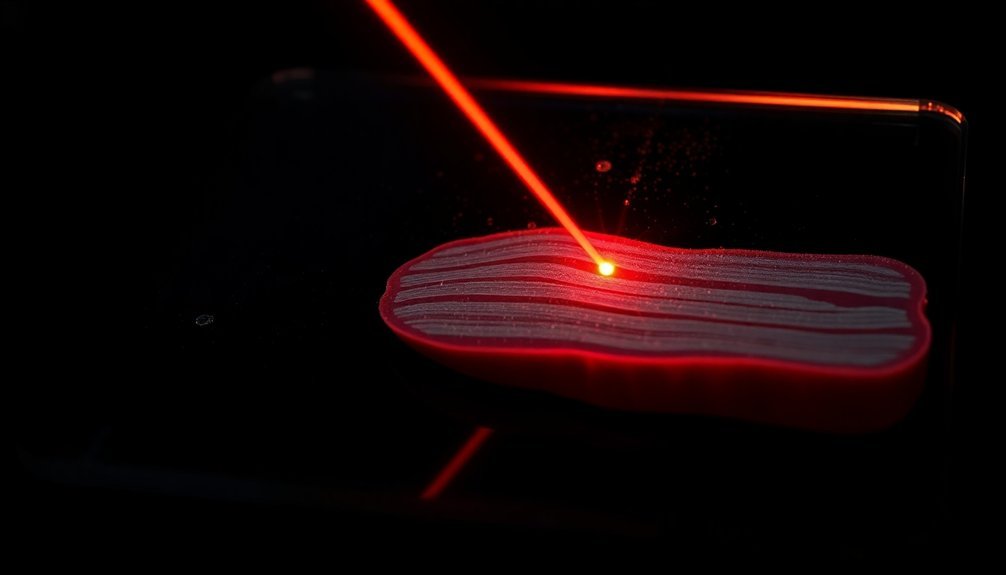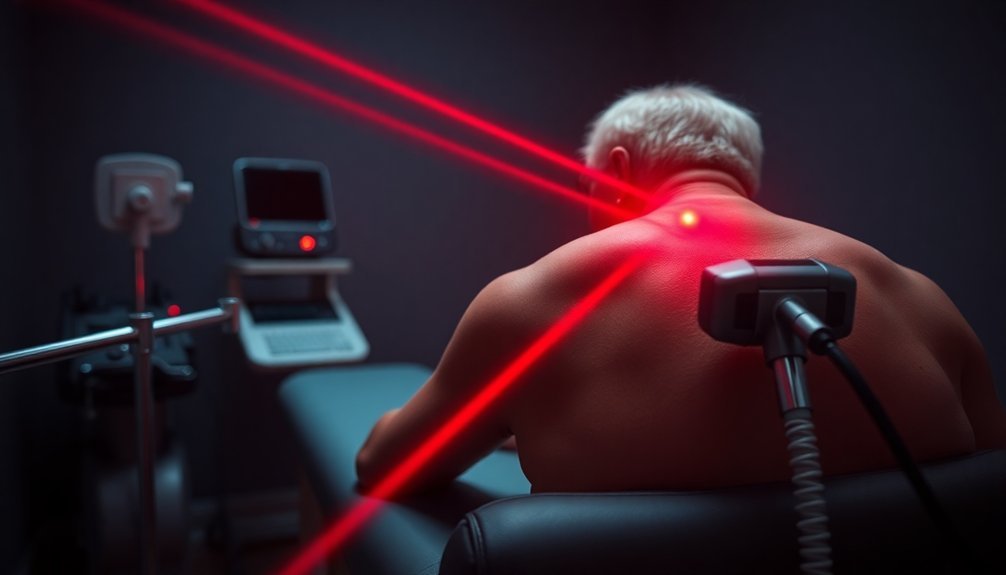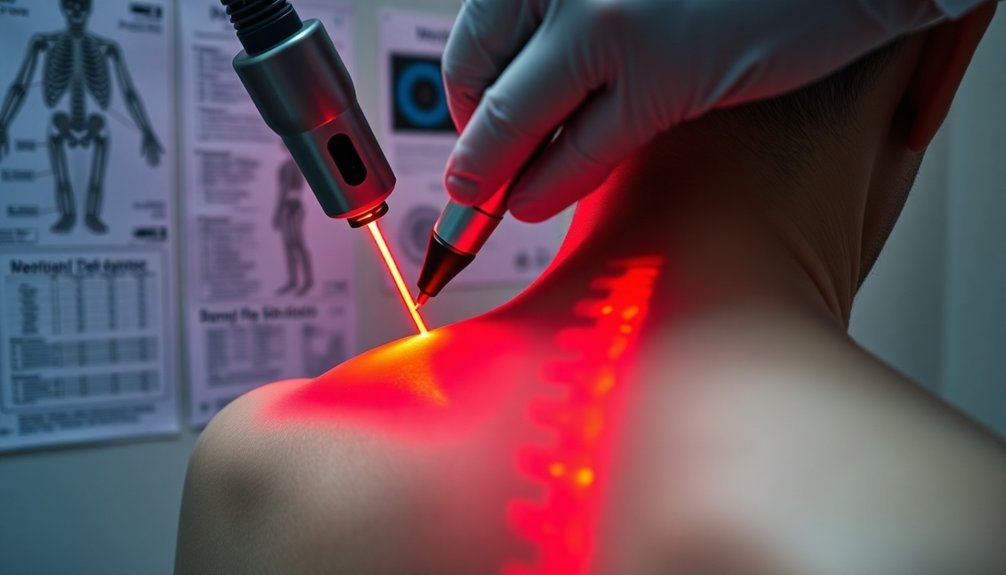Laser therapy offers a natural, non-invasive way to strengthen your bones by harnessing the power of light. When specific wavelengths penetrate your bone tissue, they stimulate cellular energy production and activate stem cells that transform into bone-building cells. You'll benefit from increased blood flow, enhanced growth factor production, and reduced inflammation – all working together to accelerate bone healing and regeneration. The treatment's proven effectiveness includes improved bone density, faster fracture healing, and long-term bone health maintenance without medication side effects. Understanding how different wavelengths and treatment protocols work can help you maximize these bone-strengthening benefits.
Understanding Laser Therapy for Bones

Through recent advancements in medical technology, laser therapy has emerged as a promising treatment for bone-related conditions. Low-level laser therapy (LLLT) works by stimulating your body's natural healing processes, particularly in bone tissue.
When you undergo this treatment, the laser energy penetrates your tissues, promoting increased blood vessel formation and enhancing bone mineral density. This approach is especially beneficial since aging-related bone loss often leads to decreased bone density.
You'll benefit from LLLT's ability to influence stem cell development and boost the production of bone matrix proteins, which are essential for bone regeneration. The treatment's effectiveness depends on specific wavelengths and dosages, with near-infrared wavelengths showing superior penetration into bone tissue.
You'll notice that LLLT alters cellular activity by helping your body absorb energy within the tissue, which simultaneously promotes healing and reduces inflammation.
What makes LLLT particularly appealing is its non-invasive nature and lack of side effects. You'll experience improved vascular activity, which helps deliver crucial nutrients to injured areas while reducing swelling.
The therapy also increases osteoblastic proliferation – the cells responsible for building new bone tissue – and enhances collagen deposition, making it an effective option for various bone-related conditions.
How Light Heals Bone Tissue
Light's remarkable ability to heal bone tissue operates through several key biological mechanisms. When specific wavelengths of light penetrate your bones, they're absorbed by cytochrome C oxidase in your cells, triggering increased ATP production. This energy boost kickstarts your body's natural healing processes, promoting the transformation of stem cells into bone-building osteoblasts. Research shows that low energy doses are most effective for stimulating optimal bone repair compared to higher energy applications.
| Process | What Light Does | Your Body's Response |
|---|---|---|
| Energy Production | Stimulates mitochondria | Increases ATP synthesis |
| Cell Development | Activates stem cells | Creates new bone cells |
| Blood Flow | Enhances circulation | Delivers more nutrients |
| Inflammation | Modulates cytokines | Reduces swelling |
You'll find that light therapy accelerates bone healing through multiple pathways. It increases the production of growth factors that stimulate new blood vessel formation and collagen synthesis. The therapy also enhances the expression of essential bone-building proteins like Runx2 and osterix. When using wavelengths between 635-980 nm at powers of 40-100 mW, you're tapping into an effective, non-invasive way to support bone repair. This natural approach complements traditional treatments while promoting faster healing and improved bone density.
The Science Behind Bone Regeneration

Your body's bone healing involves a remarkable dance between osteoclasts that break down damaged tissue and osteoblasts that build new bone material.
When you receive laser therapy, the light energy triggers increased blood flow and activates stem cells, promoting faster bone regeneration through enhanced osteogenesis.
The laser's stimulation creates a cascade of cellular responses, including the release of growth factors and the formation of new blood vessels, which work together to accelerate your body's natural bone healing process.
This healing process involves osteoblasts producing type I collagen and proteins that form the foundation for new bone tissue.
Cellular Mechanisms In Healing
When bones begin to heal, they initiate a complex series of cellular interactions that orchestrate the repair process. Your body mobilizes both resident and circulating progenitor cells, which work together to rebuild damaged tissue.
These cells respond to signals from the injury site, triggering a cascade of healing events.
You'll find that your periosteum (the bone's outer layer) contains special progenitor cells that play a vital role in the initial healing phase. These cells don't just form new bone directly – they also release factors that encourage bone formation.
Meanwhile, your body's innate immune cells guide the formation of new blood vessels and support tissue repair by attracting more healing cells to the injured area.
The healing process depends heavily on your local environment's chemical signals, which direct progenitor cells to transform into bone-forming cells. Your body's stromal cells help regulate this process by releasing growth factors and cytokines.
Class 4 laser therapy can enhance these natural mechanisms by stimulating angiogenesis and promoting osteogenic differentiation of stem cells, effectively accelerating your body's bone-building capabilities.
Osteogenesis Through Light Therapy
The molecular mechanisms behind laser therapy reveal fascinating pathways for bone regeneration. When low-level laser therapy (LLLT) hits your bones, it triggers a cascade of cellular responses that promote healing. You'll find that LLLT activates osteoblast differentiation through increased reactive oxygen species (ROS) while simultaneously inhibiting sclerostin, a protein that typically suppresses bone formation.
| Pathway | Function | Outcome |
|---|---|---|
| PI3K/Akt/mTOR | Controls cell survival and differentiation | Enhanced bone regeneration |
| MAPK/ERK | Regulates osteogenic differentiation | Improved bone cell formation |
| BMP/TGF-β | Stimulates osteoblast activity | Increased bone density |
You'll see remarkable changes at the molecular level as the laser therapy increases VEGF expression and promotes H-type vessel formation. This process enhances both angiogenesis and osteogenesis, creating a powerful healing environment. The therapy also works through the NF-kB pathway, where red laser treatment (660 nm) reduces inflammation by inhibiting phosphorylated IkBα. These mechanisms combine to strengthen your bones through increased osteoblast proliferation, enhanced collagen deposition, and accelerated bone neoformation.
Blood Flow Boosts Recovery
Blood vessels serve as essential highways for bone regeneration, carrying necessary nutrients and oxygen to healing sites. When you experience a bone injury, there's initially a decrease in blood flow, but your body quickly adapts by increasing circulation to meet the heightened metabolic demands of healing tissue.
Your blood vessels don't just transport materials; they actively participate in bone repair through specialized "Type H" vessels that release osteogenic factors and support bone-forming cells. These vessels create a favorable environment for healing by secreting signaling molecules that regulate bone cell activity and prepare the site for new bone formation.
When you undergo laser therapy, you're enhancing this natural process. The treatment stimulates angiogenesis, creating new blood vessels that improve oxygen and nutrient delivery to the injured area. This boost in circulation helps accelerate your body's healing response and can reduce recovery time.
As you age, your vascular activity naturally decreases, but laser therapy can help reactivate these important blood vessels, supporting better bone regeneration. By improving blood flow, you're giving your body the tools it needs to rebuild stronger, healthier bone tissue.
Cellular Changes During Light Treatment
When low-level laser therapy (LLLT) reaches your cells, it sparks a series of biological reactions that boost your body's natural healing processes.
Your cells respond to the light by ramping up ATP production, which provides the essential energy needed for cellular repair and regeneration.
This increased cellular energy kicks off important changes in calcium signaling and nitric oxide production, setting the stage for enhanced bone healing and tissue repair.
Photobiomodulation Basics Explained
Photobiomodulation's intricate process begins when targeted tissue absorbs photons through specialized photoacceptors, triggering a cascade of cellular changes. You'll find this therapy works primarily through your mitochondria, where it activates the cytochrome c complex to boost cellular metabolism and energy production.
| Process | Primary Effect | Clinical Benefit |
|---|---|---|
| Photon Absorption | Activates respiratory chain | Increased ATP production |
| Cellular Signaling | Modulates NO and ROS levels | Reduced inflammation |
| Gene Expression | Upregulates metabolism genes | Enhanced tissue repair |
When you undergo PBM treatment, your cells experience increased ATP production, improved signaling pathways, and enhanced protein synthesis. The therapy's success depends on specific wavelengths reaching your target tissue, with 830nm and 660nm proving particularly effective for bone repair. You'll notice these wavelengths work by stimulating your body's natural healing processes, reducing inflammation through NF-kB inhibition, and promoting cellular proliferation. The treatment's effectiveness relies on carefully controlled protocols, including precise exposure times and proper device settings, to guarantee you receive the maximum therapeutic benefit while avoiding any potential adverse effects.
Cellular Energy Production Process
The cellular energy production process during laser therapy centers on the mitochondria's enhanced ability to generate ATP. When you receive laser treatment, the light stimulates cytochrome c oxidase, a key enzyme that kickstarts increased ATP production in your cells.
This process directly enhances your body's cellular energy production through optimized oxidative phosphorylation.
You'll find that during treatment, your cells become more efficient at utilizing oxygen and nutrients. The laser therapy promotes your mitochondrial activity, often called your cellular powerhouses, leading to higher ATP levels that fuel various cellular functions.
This boost in energy production creates an environment where your cells can better repair and regenerate themselves.
What's particularly interesting is how your cells respond to this energy boost. As ATP production increases, you'll experience reduced oxidative stress within your mitochondria, which helps maintain their integrity.
This enhanced cellular energy production triggers a cascade of positive effects, including improved tissue healing and faster musculoskeletal recovery.
The process also activates purinergic signaling, where ATP molecules facilitate intercellular communication by triggering calcium release, further supporting your body's natural healing mechanisms.
Osteoporosis Treatment With Laser Technology

Modern laser technology offers groundbreaking solutions for individuals battling osteoporosis. When you're dealing with bone density loss, low-level laser therapy (LLLT) stimulates your cells through light energy absorption, enhancing blood circulation and promoting bone tissue repair.
This FDA-cleared treatment works by targeting specific areas of your body to boost cellular activity and suppress inflammation.
Your path to stronger bones through laser therapy includes these essential benefits:
- Direct stimulation of bone cells to increase density and prevent further bone loss
- Enhanced collagen production and tissue regeneration for faster healing
- Reduced inflammation and pain in affected areas
- Improved blood flow that supports overall bone health
You'll find that laser therapy integrates seamlessly with other treatments, making it an effective part of your thorough osteoporosis management plan. When you combine LLLT with regular exercise and proper nutrition, you're maximizing your potential for bone health improvement.
Clinical studies have shown that this non-invasive treatment accelerates bone healing by promoting osteogenesis and enhancing bone mineral density. If you're experiencing osteoporosis symptoms, working with a healthcare provider can help determine if laser therapy is right for your specific condition.
Light Wavelengths For Bone Health
Specific wavelengths of light play a crucial role in promoting bone health and regeneration. The most effective wavelengths fall within two key ranges: red light (660-690 nm) and near-infrared light (790-830 nm). These wavelengths penetrate deep into your tissue, stimulating cellular energy production and enhancing blood flow to your bones.
You'll find that wavelengths between 660-850 nm are particularly beneficial for bone healing. They boost your osteoblast activity, increase collagen production, and accelerate bone formation. If you're dealing with bone injuries or osteoporosis, these wavelengths can help reduce inflammation and promote faster healing.
Near-infrared light, especially around 810 nm, has shown remarkable results in improving bone density. This is particularly important if you're concerned about osteoporosis or need enhanced bone regeneration around dental implants. The therapy works by stimulating your body's natural healing processes, increasing bone mineral density, and strengthening bone structure.
Research confirms that the effectiveness of light therapy depends on several factors, including the total dose and irradiation time. When properly applied, these specific wavelengths can substantially improve your bone health by enhancing cellular regeneration and reducing inflammation.
Clinical Results and Research Evidence

Research findings strongly support the effectiveness of laser therapy in bone healing and regeneration. Clinical studies have shown that low-level laser therapy (LLLT) can enhance bone mineral density, promote callus development, and accelerate fracture healing.
Through controlled research, scientists have discovered that LLLT stimulates osteogenesis by inducing calcium deposition and promoting the formation of new blood vessels.
You'll find compelling evidence of LLLT's effectiveness in bone healing through numerous studies, with researchers documenting these key benefits:
- Increased bone strength through enhanced mineral density and improved osteogenic differentiation
- Reduced inflammation and faster healing in fracture sites
- Improved blood vessel formation (angiogenesis) essential for bone repair
- Accelerated cell proliferation and differentiation in bone tissue
While results can vary based on factors like wavelength selection and energy density (typically 1-20 J/cm²), LLLT has proven to be a valuable therapeutic tool in orthopedic practices.
You'll want to note that the most effective treatments often use specific wavelengths, such as 940 nm, which have shown promising results in clinical settings. Though more research is needed to optimize treatment parameters, current evidence supports LLLT's role in promoting bone health.
Building Stronger Bones Through Light
Light-based therapy offers a powerful approach to strengthening bones through its direct influence on cellular mechanisms. When the right wavelength of light penetrates your bone tissue, it activates cytochromes in your cells, which boosts ATP production and releases calcium – essential components for bone formation.
Near-infrared wavelengths around 850nm work best for bone regeneration, as they can reach deeper tissues. The therapy increases your bone mineral density by stimulating osteoblasts (bone-building cells) while inhibiting osteoclasts (bone-breaking cells).
It's particularly effective when delivered in short sessions of 10-30 seconds with energy densities between 4.8 and 16 J/cm².
Your bone-building process accelerates through several mechanisms: enhanced collagen deposition, increased blood vessel formation, and faster callus development during healing.
You'll benefit from the therapy's ability to trigger systemic effects, releasing growth factors that can improve bone health even in non-treated areas. The treatment also offers natural pain relief and anti-inflammatory benefits without medication side effects, making it an attractive option for long-term bone health maintenance.
Frequently Asked Questions
How Long Does Each Laser Therapy Session Typically Last?
You'll typically spend 3-10 minutes in each laser therapy session, though your treatment time may vary based on the size, depth, and complexity of your treated area. Larger areas require longer sessions.
Can Laser Therapy Be Harmful if Used During Pregnancy?
Based on clinical evidence, you can safely receive laser therapy during pregnancy as long as you avoid treatment on the abdominal and pelvic areas. Studies show no harmful effects on mother or baby.
What Are the Potential Side Effects of Laser Bone Therapy?
You may experience minor discomfort a few hours after treatment, but there aren't any serious side effects when properly administered. Remember to wear protective eyewear, as direct eye exposure can cause permanent damage.
Does Insurance Typically Cover Laser Therapy for Bone Healing?
Your insurance typically won't cover high-level or class IV laser therapy for bone healing. While some plans may cover low-level laser treatments, you'll need to check your specific policy details for coverage options.
How Soon After a Fracture Can Laser Therapy Treatment Begin?
You can start laser therapy immediately after your fracture, often within hours or days. It's safe to begin early treatment, which may help accelerate healing, reduce pain, and promote better bone formation.
In Summary
You've discovered an innovative way to support your bone health through laser therapy. By harnessing specific light wavelengths, you're stimulating your body's natural healing processes at the cellular level. Whether you're battling osteoporosis or seeking preventive care, this non-invasive treatment offers promising results. Consider discussing laser therapy with your healthcare provider to determine if it's right for your bone health journey.





Leave a Reply